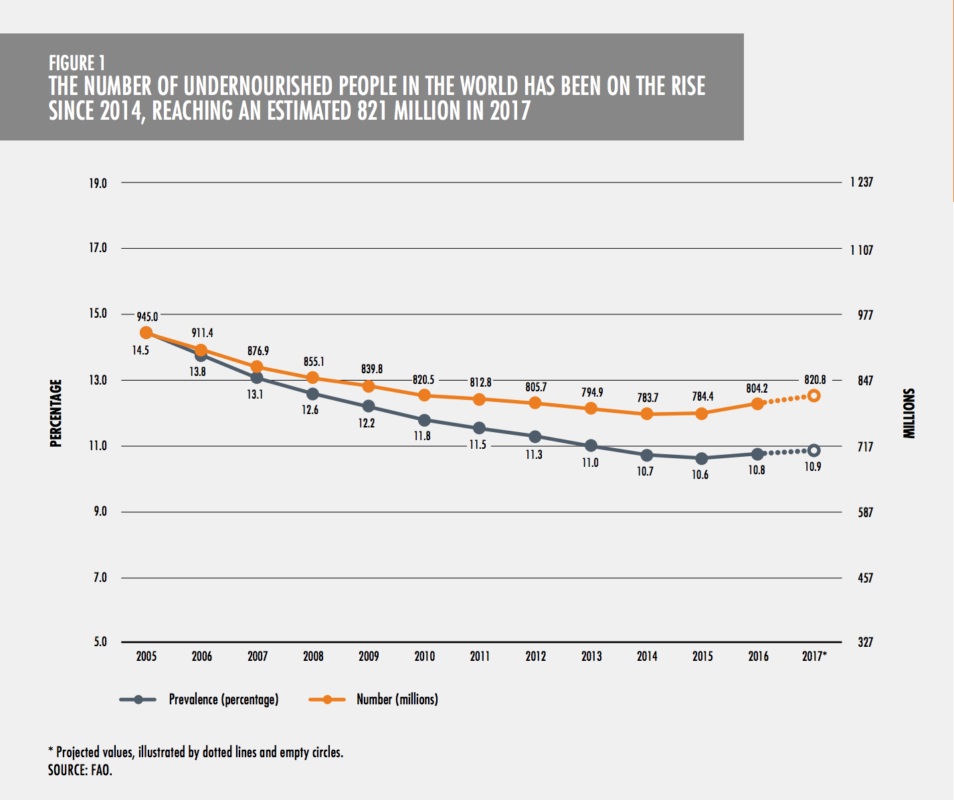One in every nine people worldwide does not get enough to eat, according to a new report from the UN’s Food and Agriculture Organization (FAO).
The FAO report found that the number of hungry people has increased for the third consecutive year and now stands at 821 million. The continued increase threatens to wipe out gains made in the global fight against hunger over the past decade.
The bulk of the world’s hungry population is in Asia, where some 515 million people do not get enough to eat and where recent improvements “seem to be slowing down significantly”. Undernourishment and severe food insecurity are also on the rise in almost all regions of Africa, where some 256.5 million go hungry, and in South America, where a “worsening” situation now means that 39 million people do not get enough to eat.

The report warns that ‘severe food insecurity,’ defined as sometimes going an entire day without eating or completely running out of food, has increased in recent years in Africa, Asia and Latin America. In Africa, nearly 30 percent fall in the ‘severe food insecurity’ category, while in Asia that number is at seven percent and in Latin America it has increased significantly to just under ten percent. By way of contrast, only 1.4 percent of the population in North America and Europe is defined as facing ‘severe food insecurity’.
Climate change a ‘key driver’ – and it’s likely to get worse
Earth’s changing climate and an increase in extreme climate events like droughts and floods are “key drivers behind the rise in hunger,” the FAO said. The Rome-based organization pointed to climate change’s effects on staple crops such as wheat, rice and maize.
“The gains made in ending hunger and malnutrition are being eroded by climate variability and exposure to more complex, frequent and intense climate extremes,” the heads of the FAO, the International Fund for Agricultural Development (IFAD), the UN Children’s Fund (UNICEF), the World Food Programme (WFP) and the World Health Organization (WHO) wrote in a joint foreword to the report.
“If we are to achieve a world without hunger and malnutrition in all its forms by 2030, it is imperative that we accelerate and scale up actions to strengthen the resilience and adaptive capacity of food systems and people’s livelihoods in response to climate variability and extremes,” the joint foreword continued.
The FAO’s report comes on the heels of two other recent warnings about the threat climate change poses to global food security. A study published recently in the journal Science warned that staple crops are expected to suffer further precipitous drops in yield as insect pest populations boom with the warmer temperatures brought on by climate change. Scientists also recently cautioned that climate change threatens to upend global markets by disrupting the trade patterns of agricultural commodities.
Although the FAO report pointed to climate change as a key factor in the continued increase of the world’s hungry, it also pointed to economic slowdowns and the prevalence of armed conflict.
Obesity also on the rise
As in last year’s report, the FAO stressed that hunger is but one type of malnutrition. Obesity also continues to be a major global challenge, with one in eight adults worldwide classified as obese. That number has increased steadily in each of the past four years. Additionally, more than 38 million children under the age of five are overweight. While the problem is most pronounced in North America, the report warns that Africa and Asia are also experiencing a steady increase in obesity.
“Undernutrition and obesity coexist in many countries, and can even be seen side by side in the same household,” an FAO news release stated. “Poor access to nutritious food due to its higher cost, the stress of living with food insecurity, and physiological adaptations to food deprivation help explain why food-insecure families may have a higher risk of overweight and obesity.”
Despite what they called “the alarming signs of increasing food insecurity”, the heads of the FAO, IFAD, UNICEF, WFP and WHO said they remained committed to achieving the ‘Zero Hunger’ goal laid out as part of the UN’s 2030 Agenda.
The full FAO report can be read here.
Main image: A farmer works his dry field in a rural area of the Philippines. Photo: Danumurthi Mahendra/Flickr
